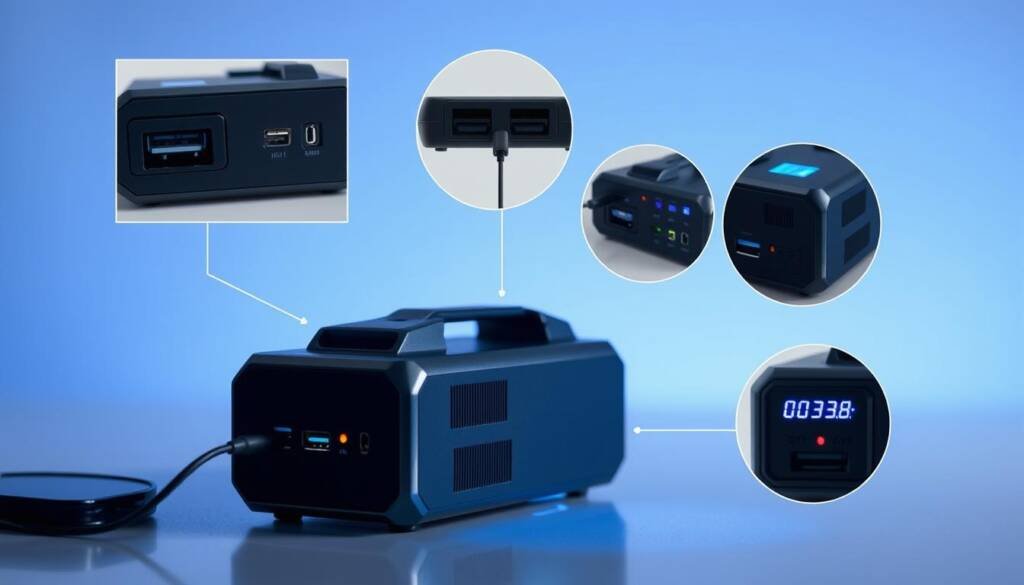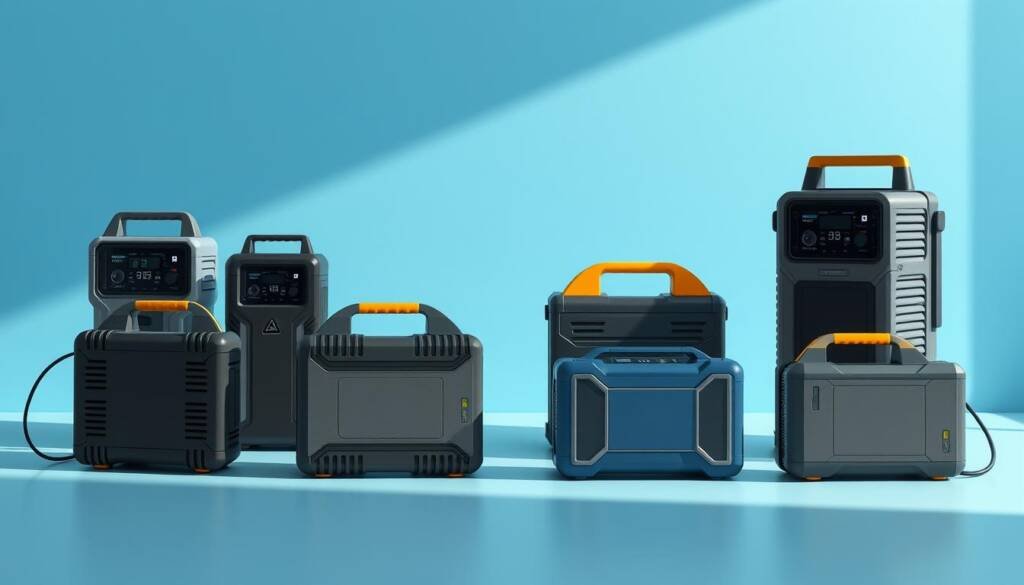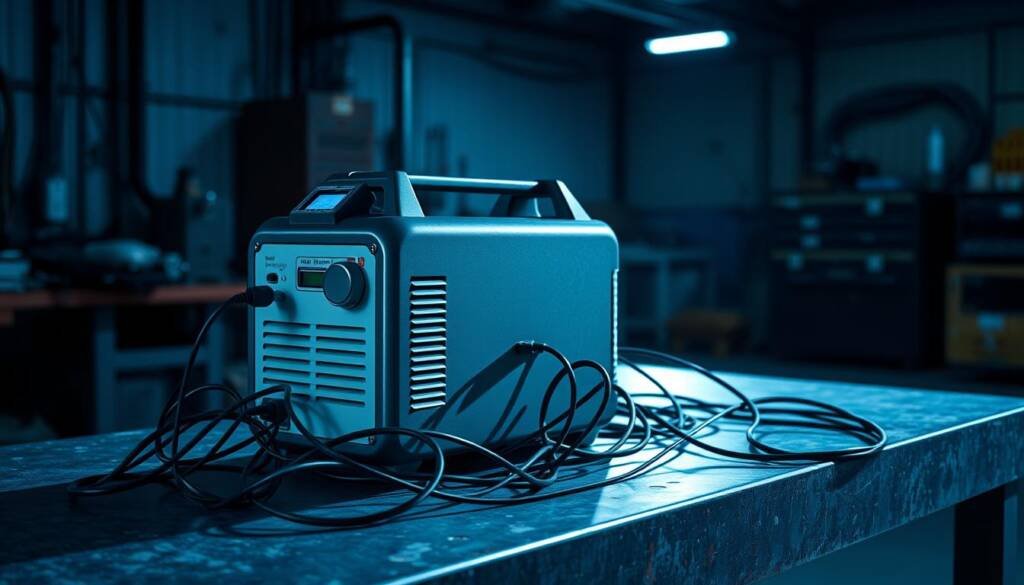Did you know that the global portable power station market, valued at $603.06 million in 2024, is projected to soar to $1,099.64 million by 2032? This staggering growth rate of 7.53% annually signals a rising demand for portable power solutions. But are portable power stations worth it for individual consumers and businesses?
As pioneers in sustainable energy solutions, we’ve seen firsthand how portable power stations are transforming the way people access and use energy. These compact powerhouses offer a blend of convenience and eco-friendliness that’s hard to ignore. But to truly understand their value, we need to weigh the costs against the benefits.
In this analysis, we’ll explore the efficiency, real-world applications, and long-term value of portable power stations. We’ll examine how these devices stack up against traditional power sources and whether they align with modern energy needs and sustainability goals.
From powering camping trips to providing emergency backup during outages, portable power stations are versatile tools. But are they a smart investment for you? Let’s dive into the details and uncover the true worth of these innovative power solutions.
Key Takeaways
- Portable power stations offer silent, clean energy for various applications
- Initial costs range from a few hundred to over a thousand dollars
- Long-term savings on fuel and maintenance can offset upfront expenses
- High-quality units can last up to a decade with proper care
- The market is growing rapidly, indicating increasing consumer demand
- Renewable charging options enhance eco-friendliness and cost-effectiveness
Understanding Portable Power Stations
Portable power stations are changing how we access electricity on the go. These compact devices store energy in rechargeable batteries, providing power when traditional sources are unavailable.
What Are Portable Power Stations?
Portable power stations are rechargeable battery packs designed to supply electricity anywhere. They use advanced lithium iron phosphate (LFP) batteries to store large amounts of energy. These units can power various devices, from smartphones to small appliances.
Key Features and Specifications
When reading portable power station reviews, pay attention to these key features:
- Capacity: Ranges from 200Wh to over 2000Wh
- Output: Can reach up to 1800W for high-end models
- Charging options: Wall outlets, solar panels, car chargers
- Ports: Multiple USB, AC, and DC outlets
- Weight: Varies from 9 pounds to over 50 pounds
Power Stations vs Generators
Unlike traditional generators, portable power stations operate silently and produce zero emissions. They’re safe for indoor use and require minimal maintenance. The best portable power stations offer eco-friendly solutions for various power needs, from camping trips to emergency home backup.
While generators rely on fuel, power stations use rechargeable batteries. This makes them more cost-effective in the long run, with some high-quality units lasting up to a decade with proper care.
Benefits of Portable Power Stations

Portable power stations offer a range of advantages that make them a valuable investment for many users. From versatility to eco-friendliness, these devices pack a punch when it comes to portable power station features.
Versatility for Different Activities
One of the key portable power station advantages is its adaptability. These units can power various devices, from smartphones and laptops to small refrigerators and power tools. Whether you’re camping, working remotely, or facing a power outage, a portable power station has you covered.
Eco-Friendly Energy Solutions
Portable power stations are environmentally friendly alternatives to traditional generators. They use advanced lithium iron phosphate (LFP) batteries, which are more sustainable than lead-acid batteries. These units produce no emissions and operate silently, making them ideal for outdoor activities and emergency situations.
Ease of Use and Portability
Despite their power, these stations are designed for easy transport and use. Most units weigh between 40 to 130 pounds, depending on their capacity. They support multiple charging methods, including solar panels, wall outlets, and car chargers, adding to their convenience.
- Silent operation
- No fuel needed
- Multiple charging options
- Safe for indoor use
With proper care, a portable power station can last over a decade, offering significant long-term savings compared to gas-powered alternatives. Their durability and efficiency make them a smart choice for those seeking reliable, portable energy solutions.
Cost Considerations

When exploring a portable power station buying guide, pricing is a key factor. These versatile energy solutions range from $130 to $1,800, catering to various needs and budgets. Let’s dive into the financial aspects of owning a portable power station.
Initial Purchase Price and Models
Portable power stations offer a wide price spectrum. Budget-friendly options like the Westinghouse iGen200s cost around $130, ideal for basic needs. Mid-range models such as the Anker Solix C1000, priced at $479, provide higher capacity and output. For those seeking top-tier performance, the EcoFlow Solar Delta 2 Max, at $1,800, offers impressive power and features.
Long-Term Savings on Energy Costs
Investing in a portable power station can lead to significant long-term savings. Unlike gas-powered generators, these units don’t require fuel purchases. Many models, like those with lithium iron phosphate batteries, can last over a decade with proper care. This longevity, coupled with the ability to charge via solar panels, translates to reduced energy costs over time.
Comparing to Traditional Generators
When conducting a portable power station comparison, it’s crucial to consider alternatives. Traditional generators often have lower upfront costs but higher ongoing expenses due to fuel and maintenance needs. Portable power stations, while pricier initially, offer clean, silent operation and minimal upkeep. They’re also more versatile, powering everything from smartphones to small appliances, making them a cost-effective choice for many users.
Ideal Uses for Portable Power Stations
Portable power stations have become essential tools for various activities. These versatile devices offer reliable power solutions for outdoor adventures, emergencies, and road trips. Let’s explore some key applications where top portable power stations shine.
Camping and Outdoor Adventures
With the rise in camping households, portable power stations have become a game-changer. They provide power for essential devices and comfort items, enhancing the outdoor experience. A 300Wh power station can keep a 60W laptop running for 5 hours, perfect for working remotely from nature.
Emergency Home Backup
During power outages, portable power stations offer crucial backup. The Goal Zero Yeti 700, with its 677 watt-hour capacity, can run a refrigerator for up to 14.5 hours. This makes it an excellent choice for keeping perishables safe during short blackouts. Pairing power stations with solar panels extends their operational life, mimicking a generator without ongoing costs or emissions.
Road Trips and Overlanding
For road trip enthusiasts, portable power stations transform vehicle-based travel. Lightweight models weighing 10-20 pounds are perfect for on-the-go power needs. They can charge smartphones, run small appliances, and even power tools. The Jackery Explorer 2000 Plus, with its high capacity and output, is ideal for longer trips or powering multiple devices simultaneously.
Portable power station applications are diverse and practical. From powering a coffee maker during a camping trip to keeping communications alive during emergencies, these devices offer independence and convenience across various lifestyles and situations.
Limitations and Downsides

When considering if portable power stations are worth it, it’s crucial to understand their limitations. Portable power station reviews often highlight both strengths and weaknesses to help consumers make informed decisions.
Battery Life and Charging Time
While portable power stations offer convenience, their battery life can be a drawback. The Anker C1000, for example, can recharge smartphones up to 75 times or run a refrigerator for over 15 hours. However, charging times can be lengthy, especially for larger capacity models.
Power Output Limitations
Most portable power stations are restricted to 120V AC outlets, limiting their ability to power large appliances. The EcoFlow Delta 3 Pro, with its 4,000-watt output, is an exception, suitable for whole-home backup. However, such high-capacity models can cost over $2,000, raising questions about whether portable power stations are worth it for some users.
Maintenance and Reliability Concerns
While LiFePO₄ batteries in modern portable power stations last longer than traditional lithium-ion batteries, they still degrade over time. Regular maintenance is necessary to ensure optimal performance. The risk of battery-related incidents is low with quality products, but it’s a factor to consider when evaluating if portable power stations are worth the investment.
Brands to Consider
When searching for the best portable power stations, it’s crucial to compare top brands. The market offers a range of options, each with unique features and capabilities. Let’s explore some leading brands and their standout products.
Leading Brands in the Market
EcoFlow, Jackery, and Anker are among the top contenders in the portable power station market. EcoFlow’s Delta Pro Ultra boasts a massive 6144Wh capacity and 7200W output. Jackery’s Solar Generator Kit 4000 offers 4085.6Wh, capable of powering a home for up to two weeks. Anker’s Solix C800 Plus provides 768Wh capacity with 1200W output.
Customer Reviews and Performance
User experiences highlight the real-world performance of these power stations. The EcoFlow Delta Pro, for instance, powered a full-size refrigerator for over 51 hours on a single charge. Jackery’s Explorer 1000 V2 ran a similar refrigerator for 18 hours, showing improved capacity over its predecessor.
Pricing and Value
Prices vary based on capacity and features. Smaller units like the EcoFlow River 2 (256Wh) are more affordable, while larger ones like the Bluetti AC240 (1536Wh) command higher prices. When comparing portable power stations, consider both upfront cost and long-term value. Factors like charging speed, battery life cycles, and expandability can greatly impact overall worth.
Future Trends in Portable Power Stations
The portable power station market is on an upward trajectory. Experts predict growth from $661.57 million in 2025 to $1,099.64 million by 2032. This surge reflects the increasing demand for reliable, mobile power solutions.
Advances in Battery Technology
Future portable power station features will likely include improved battery tech. We’re seeing faster charging times and higher capacities. The Anker 767, for instance, can recharge in under an hour. The Jackery Explorer 2000 Plus boasts a 2,000Wh capacity, expandable to 12,000Wh.
Integration with Renewable Energy
Solar charging is becoming a key portable power station benefit. The Bluetti AC200 Max can handle 900 watts of solar input. This trend towards renewable integration is set to continue, with solar-powered banks growing at 9.3% annually until 2030.
Potential Growth in the Market
The global power bank market is expected to hit $17 billion by 2024. Asia Pacific leads with a 50.5% market share. Mid-capacity units (8001-20000 mAh) dominate, holding 35% of the market. As tech improves and prices drop, we’ll likely see wider adoption across various sectors.
- Expanding capacity ranges (2,000Wh to 25kWh)
- Faster charging (full charge in 2.7 hours for some models)
- Multiple device support (up to 12 devices simultaneously)
These advancements signal a bright future for portable power stations, offering enhanced features and benefits to meet growing energy needs.
User Experiences and Testimonials
Real-world feedback sheds light on whether portable power stations are worth it. Let’s explore user experiences and insights from portable power station reviews.
Satisfaction Rates Among Consumers
Users consistently praise portable power stations for their versatility and reliability. The Anker SOLIX C1000, for example, retains 86% of its capacity after three months, outperforming competitors. This longevity is a key factor in high satisfaction rates.
Real-Life Use Cases
Campers and outdoor enthusiasts rave about units like the Jackery Explorer 1000 V2. With its 1070Wh capacity and 1500W output, it powers multiple devices for extended periods. RV owners favor the FossiBot F2400, appreciating its 2048Wh capacity and RV-specific outlet.
Lessons Learned from Users
Experienced users emphasize the importance of matching power needs to station capacity. They’ve found that portable power stations provide a reliable and eco-friendly energy for various scenarios. Weight is a crucial factor, with most 1000Wh units weighing between 27-32 lbs. Users advise considering this when planning for portability.
Overall, user experiences suggest that portable power stations are worth it for those needing reliable, portable power. The initial investment pays off in versatility and peace of mind during outages or outdoor adventures.
Final Thoughts: Are They Worth It?
After weighing the costs and benefits, we can confidently say that portable power stations are worth it for many users. These versatile devices offer a range of advantages that justify their initial investment, especially when considering long-term value and environmental impact.
Weighing the Costs Against Benefits
While portable power stations can range from a few hundred to over a thousand dollars, their benefits often outweigh the upfront costs. With lifespans of up to a decade and the ability to support thousands of charge cycles, these devices provide long-term value. Unlike gas generators, they operate silently and require minimal maintenance, leading to potential savings over time.
Recommendations for Potential Buyers
When considering a portable power station, assess your specific needs. High-capacity models like the Oukitel P5000, with its 5120Wh capacity, can power multiple devices simultaneously. For those seeking eco-friendly options, solar-compatible models offer a sustainable energy solution. Consider factors such as battery life, charging speed, and device compatibility when making your choice.